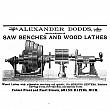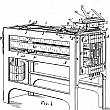Julius Berkey's Keen Eye
by Arthur S. White
The late Julius Berkey was a practical manufacturer. His ability was not developed through training by competent instructors, but by the best of teachers—experience. He had worked in a sash, door, and blind factory a number of years, saving the larger part of his earnings for the time when he could engage in the same line of production on his own account, which he did shortly before the war between the states (Civil War) broke out.
Mr. Berkey was an expert operator of wood working machinery, and to the day of his death the sound of the noisy planer, the flying chips from the moulder, and the dust from the cut-off saws pleased and interested him.
He aimed to manufacture goods with distinctive qualities, and be regarded as in a special class by jobbers or dealers purchasing them. Mr. Berkey quickly recognized the mechanical or the artistic value of an article, and sought to adapt it to the furniture trade.
A SENSE FOR NOVELTIES
Seated in a train about to leave New York City, on the New York Central railroad, some twenty or more years ago (around 1890), Mr. Berkey noticed a new form of decoration applied to the ceiling of the coach. He studied it carefully and while the ornament was crude in design and execution, he decided that it might be perfected and introduced to the furniture trade. Apparently the decoration was applied with stencils and finished with the brush by hand.
An inscription over the door of the coach informed him that the car was built in the shops of the New York Central railroad, located at Schenectady. Before the conductor had taken his ticket Berkey had resolved to call for a stopover check and to spend a few hours in Schenectady.
Not much time elapsed before he learned, after leaving the train, that a man named Underhill had executed the ornament on the ceiling of the car. He went to Underhill’s home after the railroad shops had shut down for the day. Underhill discussed the ornament in detail, and expressed dissatisfaction with his employment because he had been denied the privilege of developing his art. He had resolved to seek for employment elsewhere and had already given the master painter notice of his intention to quit. Berkey engaged his services at once for the sum of $40 per week.
The late David W. Kendall was, at that time, in the employ of Berkey & Gay Furniture Company as a designer. Berkey, upon his return to Grand Rapids, reported his discovery of Underhill and his art to Kendall, and expressed his desire to try the new ornamentation on the furniture trade. Kendall, whose ability as an artist was not confined to his work with the pencil or crayon, expressed great interest in Berkey’s plan and volunteered his assistance.
It was soon planned to bring out a number of chamber suites with plain, broad panels in the head and footboards, to which the ornament should be applied, as well as to the fronts of drawers of the cases. Underhill’s ornamentation had been applied to oak wood only, and was in the form of a branch of an oak tree with acorns. Kendall suggested that branches of the apple tree, with its white and pink blossoms, and the maple, after the leaves had been touched by frost, enriching and beautifying the them in a great variant of colors, be chosen as the subject for experiment. These were adapted and applied to the panels in effects that closely resembled the vernis Martin* and rosewood of later years.
The trade approved of the new ornament and the company took many orders for its apple blossom and maple leaf suites. After a short period of service with the Berkey & Gay Company, a rival manufacturing corporation offered Underhill $50 per week, and very soon there was a new line of Underhill suites placed on the market at lower prices. The Estey Manufacturing Co., the Widdicomb Furniture Co., and the McCord & Bradfield Furniture Co., as well as several others entered the field with the Underhill decoration. The usual result followed—the quality of the goods was depreciated; prices were cut, and the value of the ornament as a novelty was destroyed.
* Note: vernis Martin – a French imitation lacquer technique perfected by the Martin family in the 18th century.
Excerpted from Furniture Manufacturer and Artisan, May 1911, page 236

 facebook
facebook

